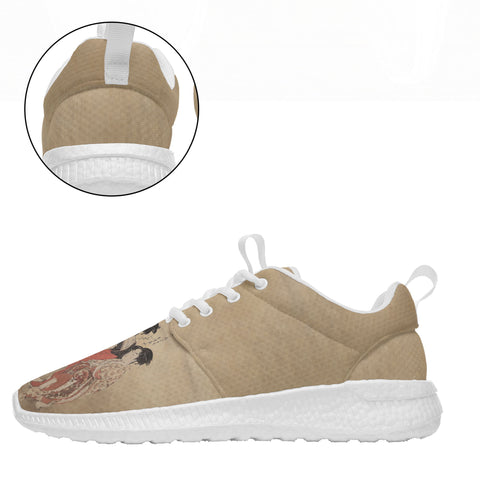Ukiyo-e Art Printing Shoes and Clothes
Custom Printed Sneakers BLD1: Ukiyo-e Kitagawa Utamaro's Three Beauties of the Present Day Sport Shoes
Custom Printed Sneakers BLD1: Ukiyo-e Kitagawa Utamaro's Three Beauties of the Present Day Sport Shoes
Couldn't load pickup availability
Adhering to a common Japanese practice with extreme frequency, Katsushika Hokusai transitioned between upwards of 30 pseudonyms throughout his career, each correlating to a different period or style. Despite the many changes, his surname prevails—Hokusai—which unites the surplus of monikers into a single legacy for the artist, printmaker, and ukiyo-e painter. In his early work, Hokusai depicted the traditional subject matter of ukiyo-e woodblock prints and paintings, Kabuki actors; however, he monumentally revolutionized the medium by shifting his focus to landscapes and images of daily life in Japan. Hokusai is best-known for his woodblock series, “Thirty-six Views of Mount Fuji” (1831), which mastered the landscape while exploring the relationship between man and environment, and contained the The Great Wave off Kanagawa, which remains one of the most universally recognized icons of Japanese art.
Gaifū Kaisei also known as Red Mount Fuji: Another print from the "Thirty-six Views of Mount Fuji" series, showing Mount Fuji under a clear with a reddish color.
"Three Beauties of the Present Day" is a classic work by Kitagawa Utamaro. The picture gathered the three most famous beauties in Edo at that time. From the shape of the corners of the eyes, the bridge of the nose and other subtle parts, the differences between different characters can be distinguished. It can be seen that Kitagawa Utamaro is creating a beauty style. Good intentions.
Takamizawa Kurozhang is a reprint of the old version. It should be a work from the 1920s and 1930s. After years of baptism, this painting has completely receded, and the hair color is very simple, but it is very strange, and the last picture Compared with the original version of this painting, the original words on this painting are not reflected in this version, and part of the hair on both sides of the character has also been cut off, so I hereby post it here as a comparison reference for the specimen.
It can also be distinguished from the family crest on the costumes of the characters. The one in the center is Toyohina Fumoto, the oiran of Yoshiwara Tamura House, and the family crest is the primrose pattern. On the left in the front row is Takashimaya Ajiu (about 1777—?), the signature girl of the tea house, with a round cypress leaf family crest. She is the eldest daughter of Takashimaya Chobei, a pancake shop in Yonezawa-cho 2-chome, Yakukenbori, Edo Ryogoku. She is a well-known beauty in the late Edo period and runs a water tea house in Ryogoku. She became famous in 1793 as a model for Utamaro's bijin paintings at the age of 17. On the right is Namba House Abei (1778—?), with the leaves of the phoenix tree. She was born in Namba House, a teahouse in Kannon-ji Temple in Asakusa. She has been influenced by her parents since she was a child. When she grew up, she became the signature girl of the teahouse, dressed in fashionable clothes, and stood at the door to attract customers. Due to its good image, it quickly attracted the attention of the public, and the teahouse business exploded. The crowd of onlookers even affected the normal business, and Ah Bei had to disperse it by splashing water. But Abei is kind-hearted, especially kind to the poor, and has a good reputation. She was the most popular beauty in the Kansho period of the Edo period. Kitagawa Utamaro used her as a model in more than 15 paintings of beauties.

Custom Printed Sneakers BLD1: Ukiyo-e Hokusai's Three Beauties of the Present Day Sport Shoes - personalized design japanese retro art style print on demand sneakers:
Custom Printed Products: Sneakers
Model: BLD1-23023003
Print Pattern: Ukiyo-e Three Beauties of the Present Day
All sneakers support custom printed pattern, logo, brand name, No MOQ and dropshipping.


Share
















